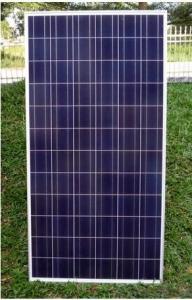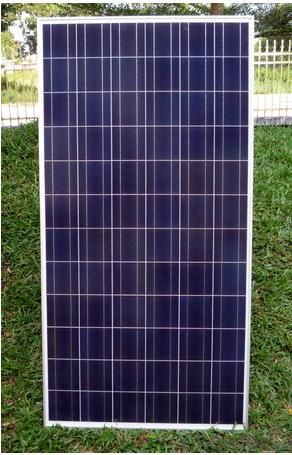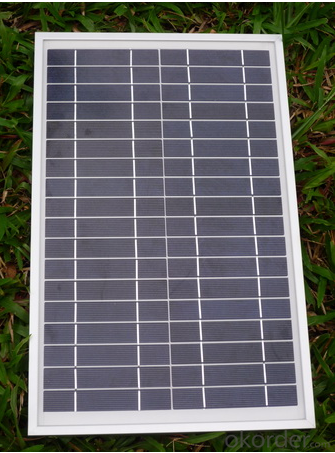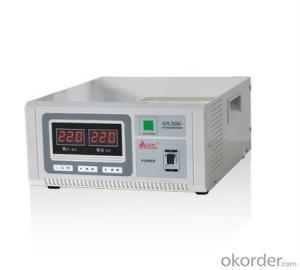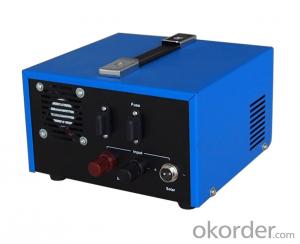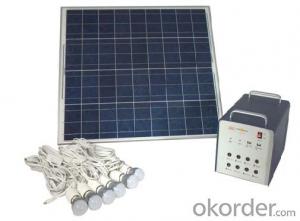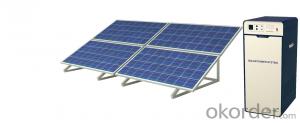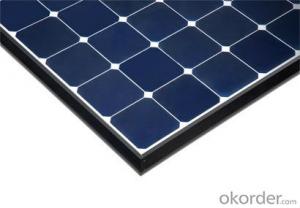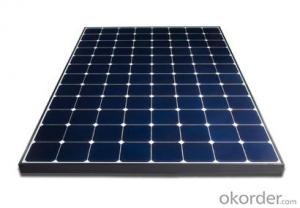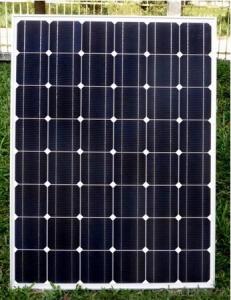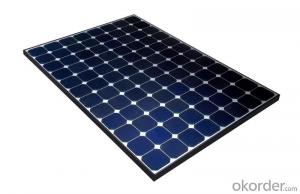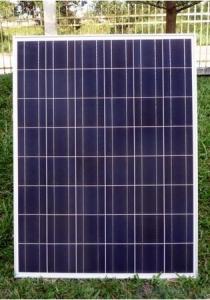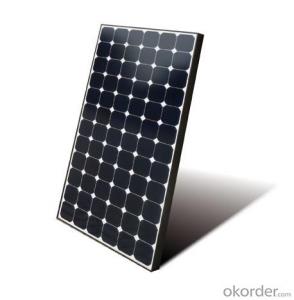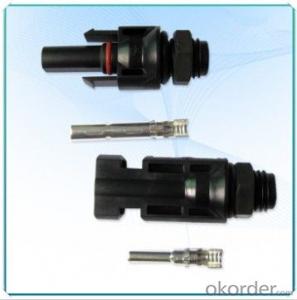Home Solar Energy Systems - CNBM On Grid System 30000W with Certificate UL, TUV, CE
- Loading Port:
- Shanghai
- Payment Terms:
- TT OR LC
- Min Order Qty:
- 50 watt
- Supply Capability:
- 1000 watt/month
OKorder Service Pledge
OKorder Financial Service
You Might Also Like
Specification
CNBM On Grid System 30000W with Certificate UL TUV CE
Product description
They range from small residential and commercial rooftop systems to large utility-scale solar power stations. Unlike stand-alone power systems, a grid-connected system rarely includes an integrated battery solution, as they are still very expensive. When conditions are right, the grid-connected PV system supplies the excess power, beyond consumption by the connected load, to the utility grid.
Connection of the photovoltaic power system can be done only through an interconnection agreement between the consumer and the utility company. The agreement details the various safety standards to be followed during the connection.[4]
A photovoltaic (in short PV) module is a packaged, connected assembly of typically 6×10 solar cells. Solar Photovoltaic panels constitute the solar array of a photovoltaic system that generates and supplies solar electricity in commercial and residential applications. Each module is rated by its DC output power under standard test conditions, and typically ranges from 100 to 365 watts. The efficiency of a module determines the area of a module given the same rated output – an 8% efficient 230 watt module will have twice the area of a 16% efficient 230 watt module. There are a few commercially available solar panels available that exceed 22% efficiency[1] and reportedly also exceeding 24%.[2][3] A single solar module can produce only a limited amount of power; most installations contain multiple modules. A photovoltaic system typically includes a panel or an array of solar modules, a solar inverter, and sometimes a battery and/or solar tracker and interconnection wiring.
The price of solar power, together with batteries for storage, has continued to fall so that in many countries it is cheaper than ordinary fossil fuel electricity from the grid (there is "grid parity").[4]
Off-the-grid is a system and lifestyle[1] designed to help people function without the support of remote infrastructure, such as an electrical grid. In electricity, off-grid can be stand-alone power system or mini-grids typically to provide a smaller community with electricity. Off-grid electrification is an approach to access electricity used in countries and areas with little access to electricity, due to scattered or distant population. The term off-the-grid (OTG) can refer to living in a self-sufficient manner without reliance on one or more public utilities. People who adopt this lifestyle are called off-gridders.[2]
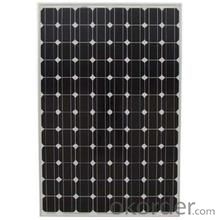
Application
Industrial
Commercial
Residential
Feature
Residential, grid-connected rooftop systems which have a capacity more than 10 kilowatts can meet the load of most consumers.[2] They can feed excess power to the grid where it is consumed by other users. The feedback is done through a meter to monitor power transferred. Photovoltaic wattage may be less than average consumption, in which case the consumer will continue to purchase grid energy, but a lesser amount than previously. If photovoltaic wattage substantially exceeds average consumption, the energy produced by the panels will be much in excess of the demand. In this case, the excess power can yield revenue by selling it to the grid. Depending on their agreement with their local grid energy company, the consumer only needs to pay the cost of electricity consumed less the value of electricity generated. This will be a negative number if more electricity is generated than consumed.[3] Additionally, in some cases, cash incentives are paid from the grid operator to the consumer.
Packaging
With carton and box
- Q: Can solar energy systems be used for powering wastewater treatment plants?
- Yes, solar energy systems can definitely be used for powering wastewater treatment plants. Solar energy systems, such as solar panels, can be installed on the roofs or in open areas surrounding the treatment plants to generate electricity. This electricity can then be used to power the various components and processes involved in wastewater treatment, such as pumps, motors, blowers, and filtration systems. The use of solar energy for wastewater treatment plants offers several advantages. Firstly, it is a clean and renewable source of energy, which helps in reducing the carbon footprint and environmental impact of these facilities. Solar energy systems produce electricity without emitting any greenhouse gases or air pollutants, making them an environmentally friendly choice. Secondly, solar energy systems can provide a reliable and consistent power supply to the treatment plants. The availability of sunlight is generally predictable, and advancements in solar technology have made it possible to store excess energy in batteries for use during cloudy days or at night. This ensures uninterrupted operation of the wastewater treatment plants, even in areas with unreliable grid connections or frequent power outages. Furthermore, solar energy systems can also help in reducing operational costs for wastewater treatment plants. By generating their own electricity, these facilities can potentially decrease their dependence on the grid, leading to significant savings on energy bills. Additionally, solar energy systems require minimal maintenance and have a long lifespan, resulting in further cost savings over the years. In conclusion, solar energy systems can be effectively utilized for powering wastewater treatment plants. They offer a clean, reliable, and cost-effective solution that not only reduces the environmental impact but also provides energy independence to these critical facilities.
- Q: How do solar energy systems impact energy education and awareness?
- Solar energy systems have a significant impact on energy education and awareness by providing tangible examples of clean and sustainable energy sources. They allow individuals and communities to witness firsthand how solar power works, understand its benefits, and learn about renewable energy technologies. This hands-on experience fosters a greater understanding and appreciation for the potential of solar energy, promoting energy education and raising awareness about the importance of transitioning to sustainable energy alternatives.
- Q: Can solar energy systems be used in areas with limited access to solar energy demonstration projects?
- Yes, solar energy systems can still be used in areas with limited access to solar energy demonstration projects. While demonstration projects are valuable for showcasing the benefits and feasibility of solar energy, they are not a requirement for utilizing solar energy systems. With proper planning and assessment, solar energy systems can be installed and used effectively in areas with limited access to demonstration projects, helping to harness clean and renewable energy sources.
- Q: Can solar energy systems be used in powering disaster relief centers or emergency shelters?
- Solar energy systems can indeed be used to power disaster relief centers or emergency shelters. In fact, these systems are increasingly being utilized in such situations due to their numerous benefits. One of the main advantages of solar energy systems is their ability to operate independently from the grid. When natural disasters or emergencies occur, the conventional power grid may be disrupted or completely unavailable. In such cases, solar panels can generate electricity from sunlight, providing a reliable and sustainable source of power for essential operations in relief centers or shelters. Furthermore, solar energy systems are highly portable and modular, making them ideal for temporary installations. They can be quickly deployed and set up in disaster-stricken areas, offering immediate power for lighting, communication devices, medical equipment, and other critical needs. Additionally, these systems can be easily expanded or adjusted to meet the increasing energy demands of relief centers or shelters as the situation unfolds. Moreover, solar power systems have minimal environmental impact compared to traditional fuel-based generators. They produce clean energy without emitting harmful pollutants or greenhouse gases, which is particularly important in disaster-stricken areas where air quality may already be compromised. Lastly, solar energy systems provide long-term cost savings. Once installed, solar panels require minimal maintenance and have a lifespan of 25-30 years. This reduces the reliance on expensive and often scarce fuel supplies, enabling relief centers and emergency shelters to allocate their resources more efficiently. To conclude, solar energy systems are a reliable, sustainable, and cost-effective solution for powering disaster relief centers or emergency shelters. Their ability to operate independently, portability, minimal environmental impact, and long-term cost savings make them an excellent choice for powering critical operations during times of crisis.
- Q: Can solar energy systems be installed on flat surfaces?
- Yes, solar energy systems can be installed on flat surfaces. While it is more common to install solar panels on angled surfaces to maximize sunlight absorption, flat surfaces can still be utilized for solar energy systems. Mounting systems can be used to tilt the panels towards the sun and optimize energy production even on flat surfaces.
- Q: Can solar energy systems be used for powering off-grid refugee camps?
- Yes, solar energy systems can be effectively used for powering off-grid refugee camps. Solar panels can be installed in these camps to harness sunlight and convert it into electricity, providing a reliable and sustainable source of power. This can be used to meet the energy needs of the camps, including lighting, cooking, heating, and charging electronic devices. Solar energy systems are cost-effective, environmentally friendly, and require minimal maintenance, making them an ideal solution for off-grid refugee camps in remote areas.
- Q: Are there any government incentives or rebates for installing solar energy systems?
- Yes, there are various government incentives and rebates available for installing solar energy systems. These incentives can vary based on location, but commonly include federal tax credits, state and local rebates, grants, and loans. These incentives aim to promote the adoption of renewable energy and help offset the upfront costs of installing solar panels. It is advisable to check with local authorities or consult with a solar installation company to determine the specific incentives available in your area.
- Q: How does the efficiency of solar panels vary across different installation locations?
- The efficiency of solar panels varies across different installation locations due to various factors such as the amount of sunlight received, the angle and orientation of the panels, shading, temperature, and local weather conditions.
- Q: Can solar energy systems be used in powering water pumps?
- Solar energy systems have the capability to power water pumps. In fact, there is a growing trend and widespread use of solar-powered water pumps. Solar energy systems consist of solar panels that convert sunlight into electricity. This electricity can then be utilized to operate various appliances and devices, including water pumps. These pumps serve multiple purposes, such as irrigation, livestock watering, and even residential or commercial water supply systems. Different types of solar-powered water pumps are available, including submersible pumps, surface pumps, and floating pumps. This variety allows for flexibility in meeting diverse water pumping needs. The use of solar energy to power water pumps not only benefits the environment by reducing reliance on fossil fuels but also offers an economically viable and sustainable solution, particularly in remote areas where access to electricity may be limited.
- Q: How do solar energy systems reduce carbon emissions?
- Solar energy systems reduce carbon emissions by converting sunlight into electricity without producing any greenhouse gas emissions. This renewable energy source replaces the need for fossil fuels, such as coal or natural gas, which release carbon dioxide and other harmful pollutants when burned for power generation. By harnessing the power of the sun, solar energy systems significantly contribute to reducing greenhouse gas emissions and combating climate change.
Send your message to us
Home Solar Energy Systems - CNBM On Grid System 30000W with Certificate UL, TUV, CE
- Loading Port:
- Shanghai
- Payment Terms:
- TT OR LC
- Min Order Qty:
- 50 watt
- Supply Capability:
- 1000 watt/month
OKorder Service Pledge
OKorder Financial Service
Similar products
Hot products
Hot Searches
Related keywords
